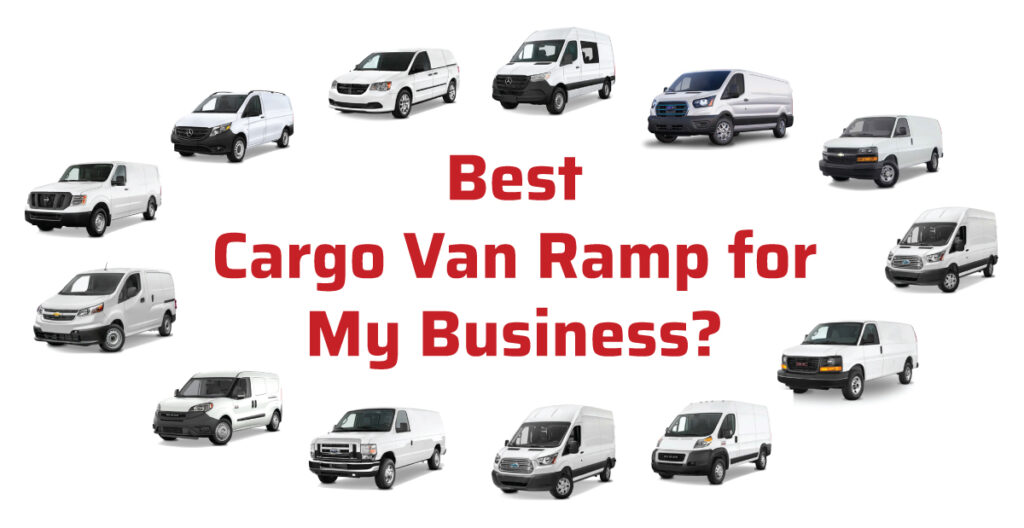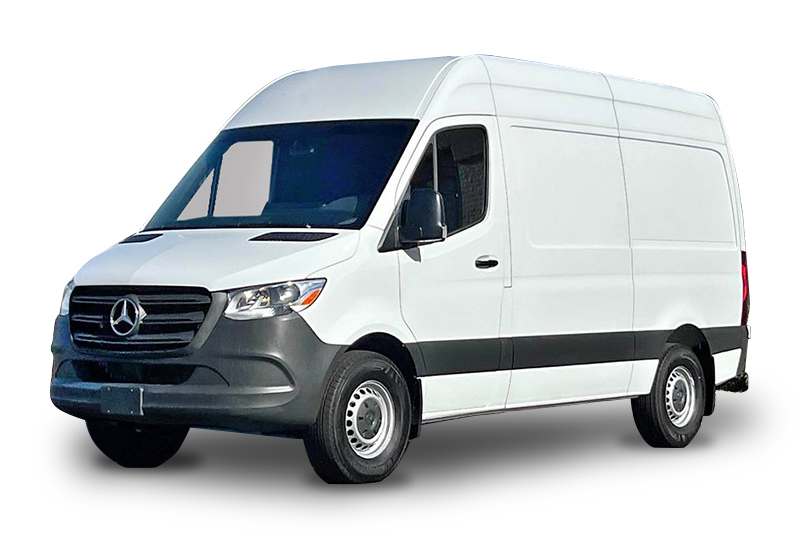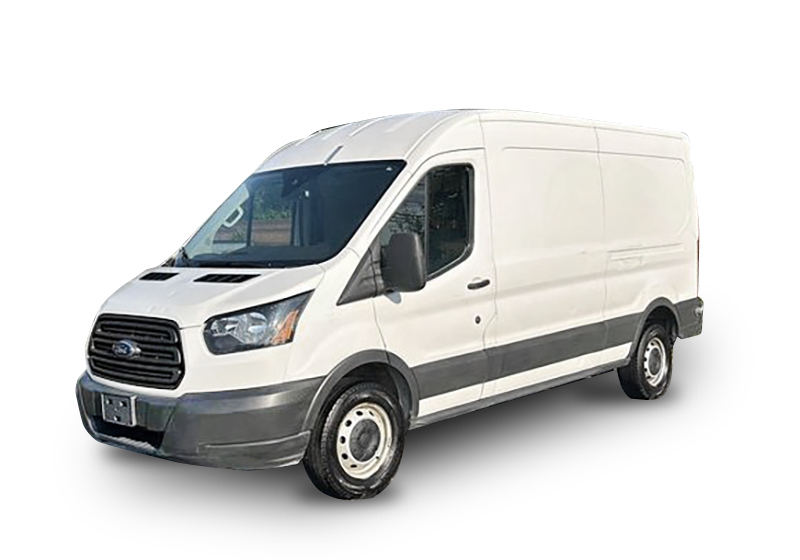How to Choose the Best Cargo Van Ramp for Your Business?

We get it, buying your first cargo van is a big decision. At first glance, the many varieties of vans across multiple manufacturers can seem completely overwhelming, like trying to count grains of sand on a beach. Luckily, you’ve stumbled upon this helpful guide on one of the most crucial parts of any delivery or shipping business: the cargo van.
A great place to start when searching for your very own cargo van is to examine what van type would best accommodate your needs, what load height would best fit your situation, and how much cargo your perfect van needs to be able to hold. Using these criteria, you can narrow down which make or model best suits your business and then discover the perfect HandiRamp cargo van ramp to enhance your business even further.
WHAT IS A CARGO VAN
Before we dive into discussing the optimal cargo van for your business, let’s first discuss what a cargo van is and its advantages over other classes of commercial delivery vehicles.
A cargo van is a commercial vehicle where the vast majority of the space is reserved for cargo as opposed to passengers. While a minivan is capable of transporting a fair amount of cargo, it has rows of seating and is specifically designed with passengers, not cargo, in mind. There are a wide variety of cargo vans available to purchase from multiple different manufacturers, each with slightly differing specifications and distinct capabilities. Three of the most popular models of cargo van are the Mercedes-Benz Sprinter van, the Ram Promaster Cargo Van, and the Ford Transit cargo van.
One of the largest alternatives to a cargo van is a straight truck or more specifically a box truck. Box trucks are also commercial vehicles primarily intended for transporting cargo, but they are generally much larger than a cargo van, not as maneuverable, and less driver-friendly. These vehicles get their name from the large compartment — or box — where cargo is stored that is separate from the main cabin and the drivers. In order to have their larger cargo capacity, box trucks are considerably taller, longer, and wider than a cargo van, with many coming in lengths of up to 26 feet and greater weight capacities. Box trucks also come in multiple variations from different manufacturers and are also compatible with HandiRamp cargo van ramps.
Besides size, one of the largest differences between a cargo van and a box truck is the ease of use. Cargo vans are considerably easier to drive and operate and are capable of easily reaching areas much less accessible to box trucks. For instance, utilizing a box truck for any deliveries or operations in tight or densely packed urban areas would be challenging, while most cargo vans would have little trouble operating in cities. For the most densely populated areas, many manufacturers also have a slightly smaller model of cargo van specifically built for easily maneuvering small city streets and compact parking. The Chevrolet City Express, Ford Transit Connect, and Ram Promaster City are some of the more popular city variations of cargo vans.
Even outside of urban areas, larger box trucks are more difficult for your business to operate than cargo vans. While a separate commercial license isn’t required to operate most box trucks, they are still much more difficult to drive than cargo vans. Box trucks can be much more cumbersome and difficult to maneuver because of their increased size. Drivers have to take extra care when turning or switching lanes so as to not miss and hit smaller vehicles, wider turns are often required, and reversing into parking or unloading areas is also harder due to impaired visibility around the back of the truck. In comparison, the process of operating a cargo van is almost identical to driving any standard car.
Most box trucks also have a very high load height that requires either a lift-gate or ramp system to load and unload cargo. In fact, with an average load height of 48” to 52”, the load floor of a box truck is often twice as high as a cargo van.
Even within just the category of cargo vans, there are multiple types suited for a range of different settings and purposes. Two of the most common specialties are the larger capacity sprinter vans and the slightly more compact city van that’s best suited for maneuvering cramped urban areas while still maintaining utility. And best of all, HandiRamp cargo van ramps are compatible and greatly beneficial for all of the following kinds of cargo vans.
SPRINTER VANS & OTHER LARGER CARGO VANS
In general, the term ‘sprinter van’ usually refers to one specific model of van, the Mercedes-Benz Sprinter, but the term can also be used synonymously for cargo van. Most sprinter vans tend to be slightly larger than the standard cargo van and have higher ceilings. The Mercedes-Benz Sprinter is easily one of the most popular and customizable cargo vans, while the standard Ford Transit and Ram Promaster could be considered sprinter vans because of their elevated roofs and larger capacities.
The Mercedes-Benz model can attribute its success and notoriety to its combination of a larger cargo area with a maintained sense of reliability and versatility. The sprinter could be best utilized by businesses that have a concurrent desire to transport larger shipments or deliveries and retain the ability to make frequent daily deliveries. For instance, a mattress delivery service would benefit from the taller cargo ceilings, which would allow for the storage of large cargo like a mattress, but also be able to easily make more frequent mattress deliveries than a similar business employing an oversized box truck would be able to.

Both the largest and smallest variations of the Mercedes-Benz Sprinter can accommodate all available sizes of HandiRamp cargo van ramp. From the Sprinter 1500 all the way up to the Sprinter 4500 Dual Rear Wheel, all five different size options of cargo van ramp are compatible with the Mercedes-Sprinter.
COMPACT CARGO VANS
As previously mentioned, many cargo vans also come in a transit or city variation for enhanced usability in smaller urban environments. For example, the Mercedes-Benz Metris is the more compact cousin of the Mercedes-Benz Sprinter, the Chevrolet City Express is the smaller version of the very recognizable Chevrolet Express cargo van intentionally designed for urban areas with a lack of spaces to park or unload, and the Ram Promaster City is the compressed sibling of Ram’s flagship cargo van the Promaster.

The Ford Transit and its city variation the Transit Connect are possibly the most popular models of cargo van. While both enjoy a plethora of features, the Connect is more fuel-efficient and has a lower roof leading to slightly less total storage. The Transit Connect would be best utilized by a business that makes frequent deliveries of medium to small-sized cargo, like online order deliveries.
Since the Transit Connect is a more compact cargo van intentionally designed for city use, the shorter cargo van ramps may suit it better. For those who really need to conserve space, the Short Ramp at only 7 feet may be the most efficient choice for your business. Luckily, however, all five lengths of the van ramp can also be fitted to the Transit Connect, not just the shorter variations.
To see which specific cargo van ramps are compatible with your specific model of cargo van, you can use HandiRamp’s free Cargo Van Ramp Configurator. This free and simple-to-use tool can identify which ramp sizes will fit into your individual model of cargo van using basic data such as the make and model.
LOAD HEIGHT
One of the most crucial aspects to consider when purchasing your cargo van is the desired load height your business requires to successfully operate. Load height, or the height between the ground and the floor of the cargo area, can drastically affect how easy it is to load and unload from a van.
Generally, HandiRamp recommends maintaining a 1:4 slope ratio for businesses transporting heavier or larger cargo. In layman’s terms, for every 1 inch of rise above the ground, you should have 4 inches of ramp, producing a very manageable 14° angle at the end of the ramp. This ratio can be tailored to your specific needs as well, for instance, businesses that don’t transport heavier or larger cargo can instead prioritize taking up little space with a Short ramp over a longer ramp with a harsher slope.
This ratio greatly depends on the load height of your van. Most city variations have shorter load heights to help ease a frequent loading and unloading process, while some larger storage capacity sprinter vans have higher load heights. The higher the load height, the more difficult it will be to unload via shorter ramps, and the lower the load height the easier to unload on a compact ramp.
OUR SELECTION
To explore the five lengths, three widths, and two different weight capacities available for HandiRamp cargo van ramps, click here. To read more about choosing the right length cargo van ramp for your business, click here, and to learn more about which ramp width best suits your business’s needs click here.
